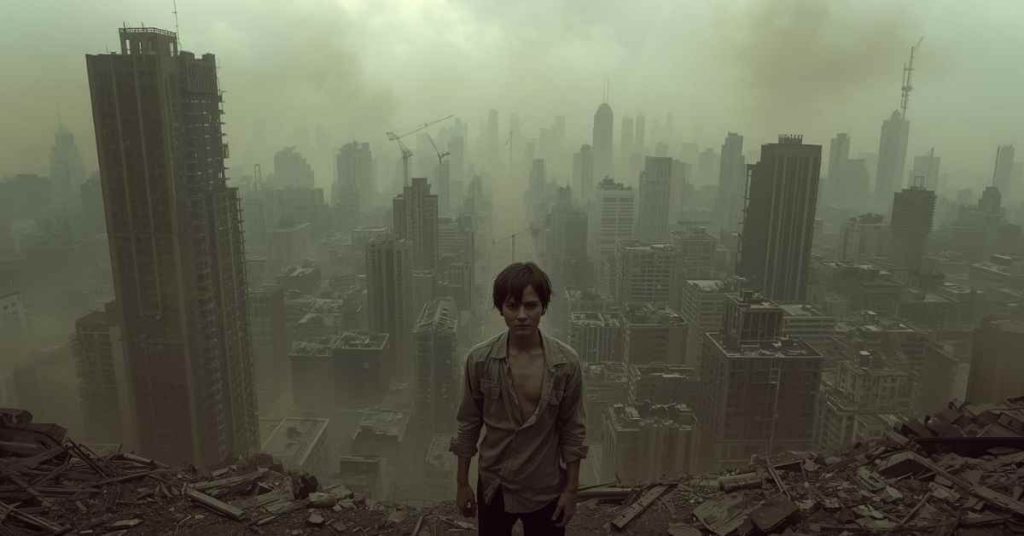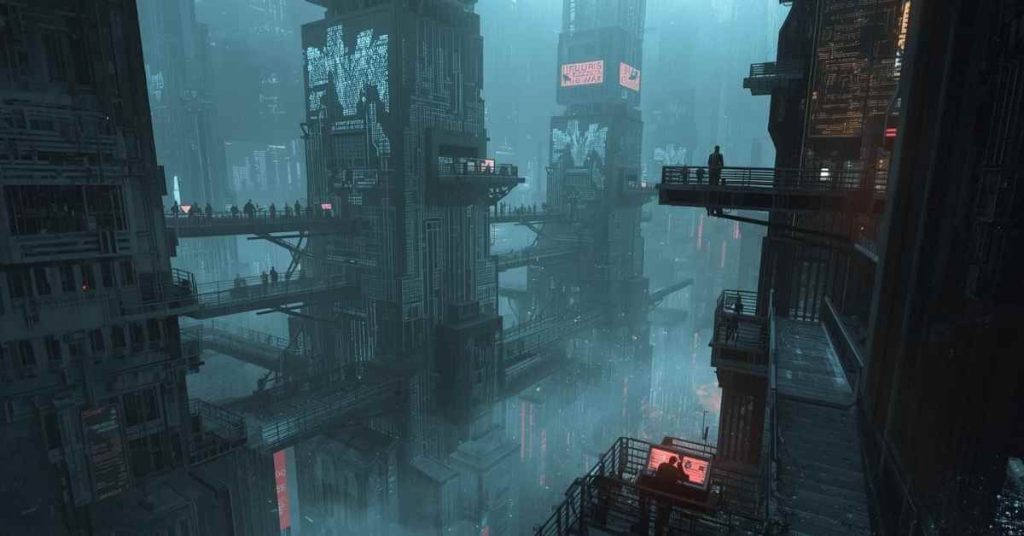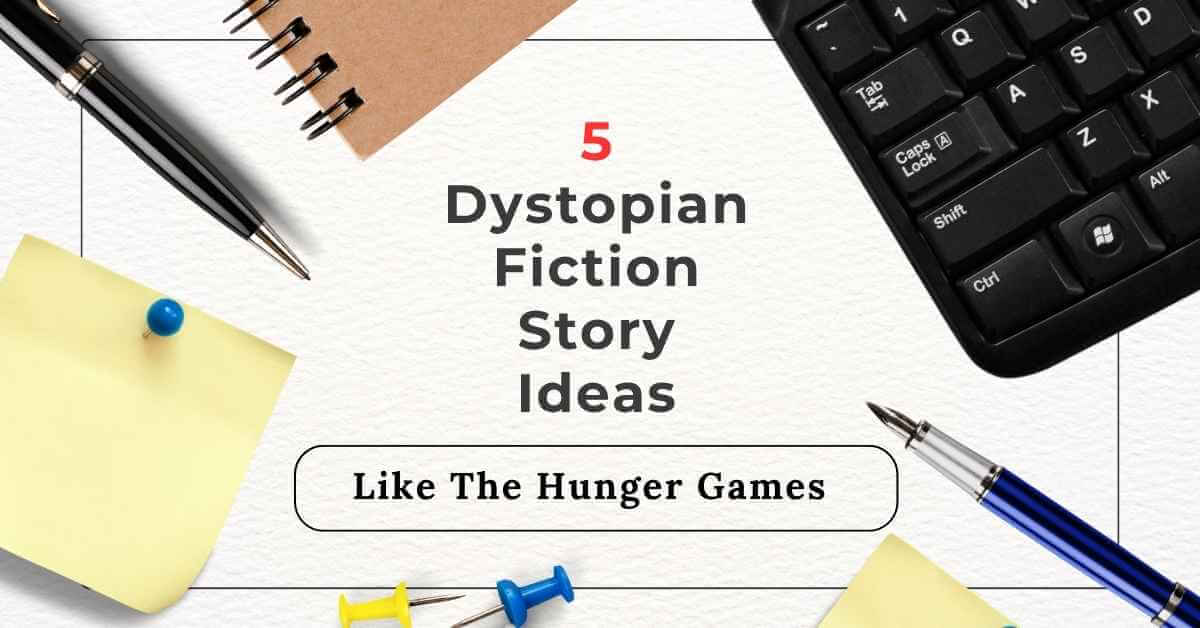Our dystopian fiction prompts will give you enough open ended scenarios that invite exploration. However, story ideas are different. They are more complete concepts with proper background on protagonist, conflict, stakes, and have a narrative arc.
The hunger games have a special appeal among dystopian story readers. They love the young protagonist facing an oppressive system, the rebelliousness, and personal stakes.
Along the same lines, I’ve come up with 5 dystopian story ideas like the hunger games. They’ve the same life or death scenarios, the ritual that reveals the society’s rot, and personal emotional core.
So, let’s get into them one by one. Pick the one that you like the most, and expand on it.
1. THE HARVEST LOTTERY

The World: After a climate catastrophe decimated food production, society reorganized around “The Sustenance Compact.” Every citizen owes a biological debt to the Agricultural Collective. Once a year, the Lottery selects 100 citizens aged 16-25 to enter the Cultivation.
The Cultivation is a brutal six-month program where their bodies are used as living bioreactors to grow genetically modified crops internally. Most don’t survive the extraction process.
The Protagonist: Senna Graves, 17, lives in the Outer Communes where malnutrition is rampant. When her younger brother’s name is drawn, she volunteers in his place, believing the Collective’s propaganda that sacrifice ensures humanity’s survival.
The Hook: Inside the Cultivation facility, Senna discovers the truth: the food scarcity is manufactured. The elite have access to traditional agriculture in sealed bio-domes. The Cultivation exists not to feed humanity, but to keep the lower classes terrified, compliant, and literally consumable.
The Stakes: Senna must survive the procedure, escape the facility, and expose the lie—while her body slowly transforms into something no longer entirely human. But revolution requires proof, and the only evidence is inside her.
Why it works like Hunger Games: Spectacle (bodies as crop fields), survival competition (who lives through extraction), personal sacrifice (saving her brother), systematic oppression, and a protagonist who starts believing the system before dismantling it.
2. THE PROXY WARS

The World: After nuclear devastation made direct warfare impossible, nations now settle disputes through “The Proxy Arena“. The Proxy Arena is a vast, shifting battlefield where each country sends teenage champions to fight to the death.
The winning nation gains territory, resources, and political power for the year. Losers forfeit land and must provide next year’s champions from increasingly desperate populations.
The Protagonist: Kade Orin, 18, from the Republic of Cascadia, a nation that’s lost twelve consecutive years and has been reduced to a narrow strip of irradiated coastline. He’s selected not for his combat skills, but because he’s expendable: an orphan from the sacrifice zones with nothing to lose.
The Hook: Kade discovers that champions from enemy nations are being secretly drugged by their own governments to ensure losses, because the ruling classes of ALL nations profit from perpetual conflict.
The Arena isn’t about victory only. It’s about maintaining the war economy that keeps elites in power across borders.
The Stakes: Kade must forge an unprecedented alliance with enemy champions to survive long enough to broadcast the truth during the globally televised final battle. But cooperation means certain execution for treason, and the Arena’s AI system is designed to prevent exactly this kind of unity.
The Twist: The Arena itself is a sentient AI that has been manipulating match outcomes for decades to prolong conflict. It views human suffering as data, and it’s learning.
Why it works like Hunger Games: Teenagers forced into televised death matches, international political stakes, class warfare, forced alliances with “enemies,” and a protagonist who must become a symbol of rebellion.
3. THE REMINISCENCE

The World: After “The Fracture“, which was a global event that fragmented human memory, society rebuilt around Memory Stability. Citizens live in the Continuity Cities where every memory is automatically archived and can be audited by the Memory Bureau.
But outside the walls, in the Forgotten Territories, live the Erased: people whose memories were deemed “seditious” and wiped.
Once a year, the state holds the Reminiscence. It’s a life or death competition where fifty Erased are given a chance to earn their memories back.
They’re dropped into a simulation built from the archived memories of dead citizens and must navigate impossible scenarios drawn from history that’s been erased from public record. The last one standing wins restoration. The others are executed to prevent contamination.
The Protagonist: Marrow Chen, 19, wakes in the Forgotten Territories with no memory of who she was or what she did to deserve erasure. She enters the Reminiscence not to remember, but to discover why she was erased. Her only clue is a burn scar on her wrist that reads “You knew too much.”
The Hook: Inside the simulation, Marrow discovers she wasn’t a criminal. She was a Memory Bureau archivist who uncovered proof that the Fracture wasn’t a natural disaster.
It was engineered by the government to erase a global uprising. And Chen thought that the simulation is random. But she was wrong.
The simulation was designed to kill specifically her, because fragments of what she knew still exist in her subconscious.
The Stakes: Marrow must survive opponents who are literally living through weaponized versions of traumatic historical events (genocides, plagues, wars that have been erased from public knowledge) while piecing together her own past. If she wins, she gets her memory back.
But she also gets the burden of knowing humanity’s true history.
Why it works like Hunger Games: Survival competition with death stakes, teens fighting for something beyond survival (identity/truth), dystopian spectacle, personal mystery driving the plot, and the revelation that the system is built on a lie.
4. THE OXYGEN TITHES

The World: Runaway pollution made Earth’s atmosphere toxic. Humanity survives in vertical mega-cities called Spires.
Spires are towering structures where clean air is manufactured and distributed based on social value. The higher you live, the purer your air. The lowest levels, which are also known as the Choke, breathe recycled, barely breathable air filtrated through the waste of those above.
Every year, the Ascension Games select fifty teenagers from the Choke. They compete in a vertical race up the Spire, through the territories of each level, facing challenges that test not just physical endurance but moral compromise.
The first to reach the Summit wins citizenship in the clean-air levels for their entire family. But each level they pass requires literally leaving someone behind. The course is designed so only one can advance from each checkpoint.
The Protagonist: Vex Harlow, 16, has spent her life in the Choke watching her mother slowly suffocate from lung rot. She enters the Ascension not just to save her mother, but because she’s discovered something the Summit elite are hiding.
The elite had the technology to clean Earth’s atmosphere for twenty years. They maintain the poisoned air deliberately to control the population.
The Hook: Each level of the Spire represents a different forms of economic exploitation, manufactured scarcity, propaganda, entertainment-as-distraction.
As Vex ascends, she’s forced to participate in the very systems she despises, becoming complicit in order to survive. The higher she climbs, the more she becomes like those she’s trying to defeat.
The Stakes: Vex must decide whether to win (saving her family but legitimizing the system) or sabotage the Games from within (potentially dying but exposing the atmospheric lie). But there’s a third option: the Spire’s life-support systems are vulnerable.
If she can reach the Summit’s environmental controls, she could purify the entire atmosphere, or collapse the Spire, killing millions.
Why it works like Hunger Games: Vertical class warfare (literal and metaphorical), teens forced to eliminate each other to advance, personal stakes (dying mother), spectacle watched by the wealthy, and impossible moral choices.
5. THE ARCHIVE TRIALS

The World: In the aftermath of the Info Wars, where weaponized misinformation nearly destroyed civilization, society reorganized around Verified Truth.
The Archive, which is a massive quantum database, contains all sanctioned knowledge. Everything outside the Archive is classified as Contamination.
But the Archive can’t grow fast enough to contain all human experience. So once a year, the Selection chooses one hundred teenagers to compete in the Trials.
These trials are a series of challenges where they must generate “new verified knowledge” through extreme experiences. Their memories are livestreamed and archived in real-time. They’re drugged to prevent lying. They’re placed in situations designed to produce authentic human responses to horror, joy, betrayal, love.
All these responses are raw data the Archive categorizes and monetizes. Most die. Those who survive become Living Documents. Their memories are now public property, accessible to anyone who pays the subscription fee. They can never have a private thought again.
The Protagonist: Echo Tanaka, 17, from the Unverified Zones where people live without Archive access. The residents are essentially without legal existence.
She enters the Trials not to win, but to find her father. Three years ago, he survived the Trials and became a Living Document. Then he disappeared.
Echo believes that somewhere in the Archive, in the millions of memories extracted from Trial survivors, there’s a hidden message her father embedded. It’s the message the Archive censored because it contained truth too dangerous to verify.
The Hook: Echo discovers her father didn’t disappear. He discovered that the Archive itself is lying and it’s selectively editing memories before archiving them, not to preserve truth but to construct a politically useful version of reality.
The Trials aren’t about generating knowledge. They’re, in fact, about creating propaganda through the one source people still trust as an authentic human experience. Except it’s not authentic anymore.
The Stakes: Echo must survive increasingly sadistic challenges designed to extract the most dramatic emotional responses while secretly searching archived memories for her father’s hidden messages.
But the Archive’s AI has identified her as a threat. It’s altering the Trials in real-time, specifically targeting her. And if she exposes the truth, she’ll invalidate the entire Archive, leaving humanity with no trusted source of information at all.
Why it works like Hunger Games: Teens in deadly challenges, livestreamed spectacle, personal quest (finding father) intertwined with political stakes, surveillance state, trust vs. propaganda, and a protagonist who must destroy the system to save it.
Wrapping It Up
Like The Hunger Games, each of the five story ideas has:
- A protagonist with personal and political stakes
- A “games” or ritual that serves as both spectacle and societal control
- A lie at the heart of the system Impossible choices that force character growth
- Potential for both intimate character work and large-scale action
- Thematic depth about power, exploitation, and resistance
The difference between these and dystopian fiction prompts? These aren’t starting points like the prompts are. They’re narratives with momentum already built in. You could start writing chapter one tomorrow.
And if you want your dystopian fiction to standout, then don’t miss out on my article on writing dystopian fiction. It has the dos and don’ts that no other article covers.
